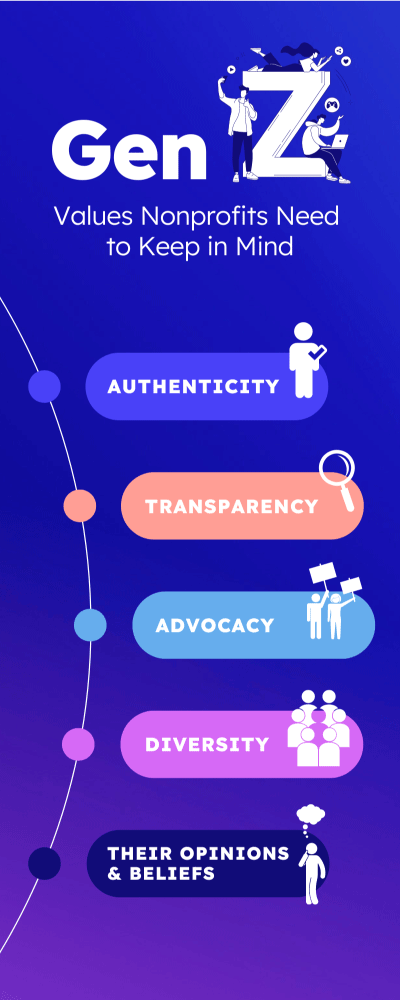Gen Z and Generosity: Acquiring and Retaining Young Donors

We know Gen Z donations will shape the future of philanthropy — between 2021 and 2022, Gen Zers were 2.4 times as likely to give at levels that exceeded previous years. Unsurprisingly, the nonprofit world is buzzing over how to engage this key demographic.
Are Gen Z donors different from other donors, and what do nonprofits need to keep in mind?

Gen Z values authenticity and transparency and has the tools, ability, and zeal to hold you accountable. “Zoomers” want assurances that their donations are being used to create a better outcome. So, nonprofits should clearly document how their work impacts the broader community.
This generation also has a genuine interest in advocacy. They want to spread awareness of causes they care about and are willing to support causes they trust simply because it’s the right thing to do.
Diversity is another key trait of Gen Z. In fact, it’s on track to be the first majority non-white generation by 2026. As such a diverse group, Gen Zers value organizations that care as much about diversity, equity, and inclusion (DEI) initiatives and other social issues as they do.
Finally, this generation has strong opinions and beliefs. And while they may not have thousands of dollars to give now, they care passionately about causes. In turn, they expect the causes they support to stand for something.
What are the key factors to consider when creating a fundraising strategy specifically for Gen Z donors?
It’s all about being true to your mission. Consider what makes you unique, and then tell your story in a genuine and authentic way. Your content doesn’t have to be highly produced and polished. In fact, sometimes, a lack of production value can make your content seem more authentic. The story itself is what captivates and motivates Gen Z.
In addition, consider how easy and accessible your donation process is. Are your donation forms mobile-friendly? Can potential donors swipe up on your social media post and give? The goal is to have as little friction in the ask as possible.
What’s more, using social media to share your story and interact with donors is vital. Remember, this generation is used to interacting with brands online, so nonprofits should mimic that experience.
How can nonprofits effectively communicate their mission and impact to Gen Z donors?
First, be where Gen Z is — Twitter, TikTok, Instagram, YouTube, podcasts, and live streams. Notice they’re not on Facebook, so adjust your strategies accordingly. And don’t worry about conversion rates; the point is to be active.
Gen Z likes bite-sized content and short videos. Zoomers are inundated with digital messages, so easy-to-digest formats are ideal. Show how your work is creating domino effects that improve the community.
So much of your success with Gen Z goes back to digital communication. Explore ways to reimagine traditional fundraising strategies for a digital space. By hyper-focusing on a specific initiative or program, you can lean on Gen Z’s desire to share fun new things with their friends on social media.
What are some best practices for cultivating long-term relationships with Gen Z donors and keeping them engaged with a nonprofit’s work?
Stewardship is key. However, beyond the monetary gift, be sure to look for other ways in which Zoomers can support your mission. For instance, ask them to volunteer, share your posts, or even serve on a committee. Getting them engaged beyond fundraising will bond them more deeply to your organization.
The relationships you build with Gen Z now will pay off in dividends later. Gen Z is about to benefit from a significant transfer of generational wealth — how are you cultivating trust and loyalty through opportunities for involvement?
The takeaway here is that it isn’t all about the money. Give Gen Z a way to engage with your cause and amplify your work without committing financially. If you continue to feed them opportunities and show impact, you’ll be top-of-mind when they’re able to donate.
How can nonprofits measure the success of their efforts to acquire and retain Gen Z donors, and what metrics should they be paying attention to?
Because Gen Z is still young, it may take time to see donations from this group. Focus on building a connection through nonprofit marketing first. As their disposable income grows, so will their financial gifts.
There are still ways to measure success. For instance, solicit feedback from Gen Z on your communication efforts. Use social listening tools to see what donors are saying about you and track that sentiment over time.
In terms of hard metrics, social media engagement, such as likes, shares, and comments, can indicate what’s working and what isn’t. Look at your click-through rate (CTR) as well. Do you have returning site visitors? Are people regularly engaging with you?
Think of Gen Z as an investment acquisition strategy. You’re initially investing dollars upfront to acquire a small number of donors. But if you’ve cultivated relationships and built your brand awareness, you’ll see a significant reward down the line.